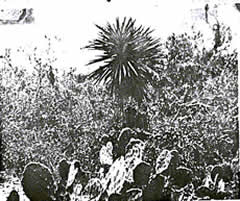
OLD FORT ST LOUIS
VICTORIA COUNTY TEXAS
FOUNDED IN 1685
BY
ROBERT RENE de LA SALLE
It was two hundred and seventy years ago when La Salle disembarked from the Belle, his only remaining ship, and started the settlement. This settlement was intended to be a permanent colony by the French in the New World and was to be used at a later time for a jumping off place by the French in an effort to oust the Spaniards from Mexico. Between some two and three hundred Europeans lived at this site. La Salle himself lived here from 1685 to the spring of 1687. He was murdered in that year by some of his own companions. The colony lasted after the death of La Salle two more years but by then all of the inhabitants were either dead from disease, had deserted, or were killed off by the Indians. When the settlement was found by the Spaniards in 1689 it was in total ruin. See historical and reference note on old Fort St Louis at end of narrative. June 25 1955 DRAWINGS

Actual site of the fort or settlement on the bluff . West bank
of the Garcitas Creek- Brush, Spanish Daggers and catus [sic] have overgrown
the whole site.
I have in my possession fragments of blue and white porcelain of very antique make which I gathered up from the surface of the ground at the site. Also much Indian pot-herds [sic] found at the site, some lead and other artifacts indicating a European settlement.
Photographs of La Salle monument on Matagorda Bay near old Indianola:
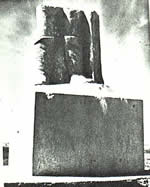
#1. Base of an old monument erected to
the memory of La Salle at old
Indianola Texas on Matagorda Bay
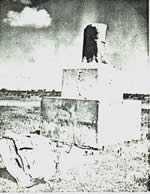
#2. Rear view of the old La
Salle monument showing
broken part of body laying
on the ground.
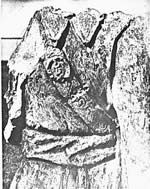
#3. View of the broken part of
old monument. Body on
ground at the rear of the
old La Salle monument.
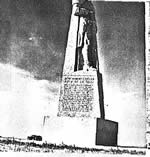
#4. Robert Cavalier de La Salle
Statute [sic] erected by the state of Texas
at La Salle landing on Matagorda Bay
near the old town of Indianola
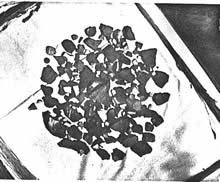
Broken pottery (pot-herds) [sic] found at the site of the old
fort.
Note: Some of the above are European porcelain and pottery.
*****
Indian shell heep [sic] on the Matagorda Bay
made by the Karankawa Indians
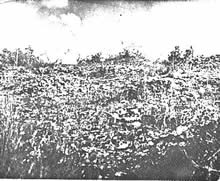
Indian Shell Heep [sic]
HISTORICAL AND REFERENCE DATA ON THE OLD FORT ST LOUIS
Robert Cavelier Sieur de La Salle was born in November of 1643 at Rouen France and was murdered by his own companions on 19th of March 1687 in Texas.
La Salle sailed from the port of Rochefort August 1, 1684 on his second voyage to the new world to found a colony at the mouth of the Mississippi River. He had with him some 280 to 300 people and 4 ships.
La Salle missed the Mississippi and came on to land on the Matagorda Bay near where the old town of Indianola used to be. Of the 4 ships in his expidition [sic], one, the St. Francis was captured by the Spaniards on his entering into the gulf. And in crossing the bay the Aimable, which was his state ship, was wrecked and lost in the Matagorda Bay. La Salle and his naval officer, Beaujeu, could not agree and here on the Matagorda Bay[,] Beaujeu took the Jolly [sic] and sailed away.
La Salle now with only one ship, the Belle, left [and] scouted out the bays, also the Lavaca Bay, and located a site at the head of Lavaca Bay up one of the rivers[,] (the Garcitas), a few miles, for his settlement and named the settlement Fort St. Louis for the King of France, Louis the XIV.
La Salle lived here at Fort St Louis tell [sic] the 7th January 1687. And at that time only about 40 person[s] were left at the colony. All having died of disease or killed off by the Karankawa Indians. [They were] a very fierce tribe who lived along the coast and never did stop fighting La Salle.
The colony was in a bad condition. The only ship[,] the Belle[,] was also wrecked on a shoal in Lavaca Bay. With this loss there was no way left now to ever leave the colony and return to France. So on the 7th January 1687 La Salle with some of the colonist[s] left Fort St. Louis to try and [find] the mouth of the Mississippi where he had an appointment with one of his fellow explorers, a[n] Italian by the name of Tonty. La Salle could [have] brought out all of the remaining colonist[s] or could [have] brought help to his settlement if he had been allowed to live.
La Salle, while on this trip to join Tonti's party [that was] waiting for him at the mouth of the Mississippi, was murdered by his own companions on the 19th March 1687 in East Texas. Some of La Salle's men did push on and did join Tonty's camp. Others, the murderers, came back to the fort. Things were now worse and by 1689 there was no one living there at all and the fort and settlement was in ruins.
Histories and References in regard to this old settlement are:
Tonti - The man waiting at the mouth of the Mississippi
Joutel- Who was with La Salle when murdered
Sparks- Life of La Salle
Shea- Discovery of the Mississippi
Parkman- Discovery of the Great West
LGrauier- Discoveries and Establishment of Cavalier De La Salle
Texas has a county named after La Salle and a town. La Salle Texas in Jackson county in the memory of the galant [sic] explorer.
Notes on La Salle
From History of our Country by Edward S. Ellis- A.M. 1895
De La Salle was commissioned by the King (Louis 14th) to plant colonies in Louisiana and to govern the enormous territory from the Michigan to the gulf.
The Jolly [sic] was a war ship of 36 guns. La Salle had a force of marines,100 soldiers and nearly 300 other persons including women and children.
June 6, 1685 - Entered a pass and landed on Matagorda Island and set up a temporary camp.
Argument - had a[n] argument with the captain of the Jolly [sic] and it sailed back to France 3/12/1685
Fort - Explored head of Lavaca Bay and builded [sic] a fort - mostly out of logs. The fort was finished in July 1685 and named Fort St Louis.
20 men left at the fort when La Salle left the last time to try and locate the Mississippi River in January.
Moranget - Nephew of La Salle - went with La Salle on this
trip.
Duhaut - Another man in the colony also went along.
La Salle
The Trip - La Salle and his party left the fort in January, but it rained every day, compelling them to stay in camp most of the time. This idleness caused discontent and set the explorers to plotting, a fact which La Salle did not know anything about.
About the middle of March1687, La Salle was at a spot on the southern branch of the Trinity River where on a previous visit he had buried a quantity of corn. Here, he sent some of his men to recover the corn. Among this party was La Salle's nephew Moranget and Duhaut. They found the corn but it was spoiled. Luckily[,] they killed a buffalo and sent back to camp for a horse to carry the meat into camp.
Killing of Moranget - An argument over the cutting up of the meat between Moranget and Duhaut ended in the killing [of] Moranget. This fight split the little band into two factions. Duhaut and his friends then conspired to kill La Salle at first opportunity.
Murder of La Salle - This opportunity was not long in coming
La Salle got anxious about his nephew and with one companion started out to look for him.
Nearing the plotters camp, La Salle fired a shot to let them know that he was coming [and] this warned them of his approach and gave them time to secret themselves along the path which he would take in his approach to the camp. 2 shots from the cane brakes brought him down, lifeless.
The murderers stripped La Salle of all of his clothes and left his body naked to the prey of the wolves.
The murder of La Salle did not become known in France till October 1688. Nothing was ever done by France.
The Fort - to rescue the miserable remnant of La Salle['s] colony.
No Arrest - An order was sent to the governor of Canada to arrest the murderer of La Salle if he should ever show up. No one was ever punished for the murder of La Salle.